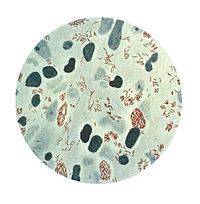Mycobacterium leprae facts for kids
Quick facts for kids Mycobacterium leprae |
|
|---|---|
 |
|
| Microphotograph of Mycobacterium leprae taken from a skin lesion | |
| Scientific classification | |
| Kingdom: | |
| Phylum: | |
| Order: |
Actinomycetales
|
| Suborder: |
Corynebacterineae
|
| Family: | |
| Genus: | |
| Binomial name | |
| Mycobacterium leprae Hansen, 1874
|
|
Mycobacterium leprae is a tiny living thing called a bacteria. It is known for causing a long-term disease called leprosy. Leprosy is also sometimes called Hansen's Disease. This name comes from the doctor who discovered the bacteria.
Contents
What is Mycobacterium leprae?
Mycobacterium leprae is a type of bacteria that causes a disease called leprosy. This disease mainly affects the skin, nerves, and eyes. It can also affect the upper respiratory tract. The bacteria grows very slowly. This means it can take a long time for symptoms to appear after someone is infected.
Who Discovered M. leprae?
A doctor from Norway named Gerhard Armauer Hansen found this bacteria. He made this important discovery in 1873. That's why leprosy is sometimes called Hansen's Disease. Dr. Hansen's work was a big step in understanding this disease.
What Does M. leprae Look Like?
M. leprae is a special type of bacteria. It is shaped like a rod and needs air to live. It has a thick, waxy coating around it. This coating is a unique feature of bacteria in the Mycobacterium family. Because of this waxy layer, scientists use special dyes to see it under a microscope. It looks very similar to M. tuberculosis, which causes tuberculosis.
Images for kids
-
Gerhard Armauer Hansen (1841–1912), who first discovered M. Leprae in 1873
See also
 In Spanish: Mycobacterium leprae para niños
In Spanish: Mycobacterium leprae para niños




